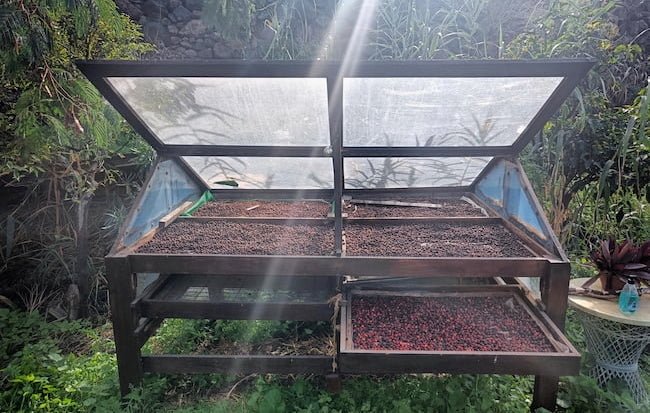If I had to look back, I’d say that there is one clear point marking a “before and after” in my coffee journey.
You could call it a point of no return.
I have loved coffee for most of my adult life, but it wasn’t until I went to a coffee farm for the first time that I started to ‘respect’ the cherry.
When you’re a coffee drinker in a Western country, most likely you’ll only encounter coffee in a highly processed state. Many people never understand that coffee is a fruit.
When you get to the coffee plantation for the first time, this will become abundantly clear.
If you love nature and you consider yourself a real coffee snob, there’s no better way to spend a holiday than going to the origin.
Here are my best tips and tricks to plan your coffee origin trip.
Visit the bean belt
The biggest obstacle to visiting a coffee farm for most people is that they are located in faraway countries. So, the first step is to go and visit a country that you’re interested in that also produces coffee.
If you want inspiration, you can look at what’s called ‘The bean belt.’ This is (roughly speaking) an area marked by the Tropic of Capricorn in the South and the Tropic of Cancer in the north.
Arabica coffee needs certain environmental conditions to grow, so it mostly exists in mountain areas close to the Equator. The closer the coffee is to this line, the higher altitude it needs to thrive.
The main centers for coffee production are, of course:
- Central & South America
- The Carribbean
- East Africa
- Asia
Since infrastructure is a lot more challenging in Africa, I’d suggest that you visit a coffee plantation in one of the other regions.
Luckily, there are many places in Asia and Latin America. Not only for coffee, but also for vacation in general.
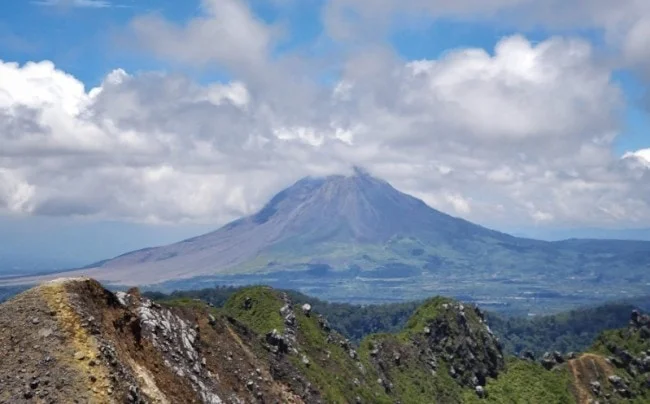
For instance, you can go to Sumatra and see some stunning nature at Lake Toba, and visit a coffee farm at the same time. Sounds, epic right? It definitely is. I went there back in 2019, and it was one of my best origin trips ever.
Coffee in Spain?
However, even though most farms are located in exotic countries far away, you might still be surprised at what’s growing nearby.
Recently, I visited the Spanish island of Gran Canaria and went to a small coffee farm there, named Café Platinium.
Most people have never heard about Spanish coffee, and that’s not surprising since the production is tiny.
Most of the island is not suitable for coffee production, but in the Agaete Valley, the microclimate is just right. There are a handful of farms there, and many locals grow coffee trees in their backyards.
I hadn’t done much planning but was able to get to the farm with a combination of public transportation and a taxi the last stretch of the way.
If you rent your own car, visiting the valley would be super easy.
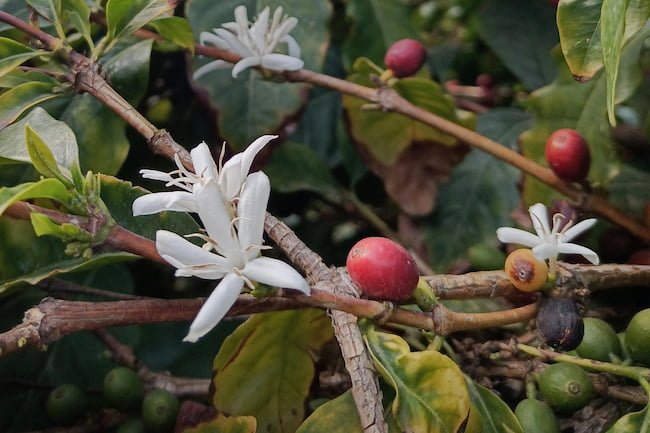
Visiting the farm (and the beautiful valley in general) was one of the highlights of my trip. The owner and staff at the farm were very kind and even offered me a lift back to Las Palmas; the island’s capital.
Admittedly, the farm probably is probably a bit more of a tourist attraction rather than a typical farm, where agricultural output is the main activity. Nonetheless, it was still a beautiful experience to visit the Agaete valley, see the coffee cherries on the trees (as well as a wide range of other fruit trees), and try the local beans.
The good thing about visiting coffee farms is that it’s almost always an excellent way to get out an experience some beautiful views and green vegetation.
If you keep your eyes and ears open, you might encounter other opportunities like this, when you’re on holiday.
Besides classic coffee destinations such as Brazil, Colombia, and Ethiopia, there are dozens of unexpected places where you can find coffee growing.
What about California, Australia, Taiwan, or the Azores of Portugal?
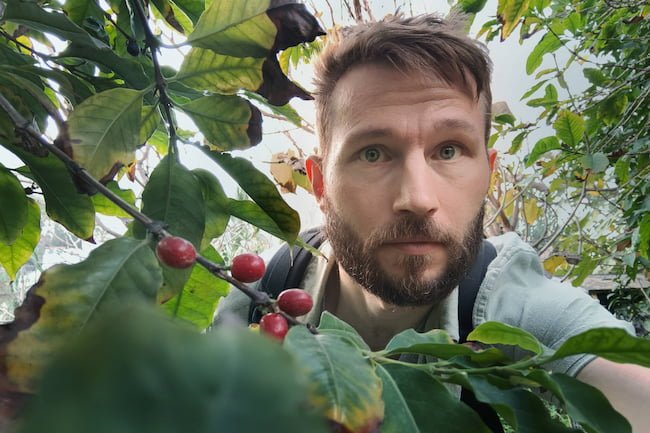
Consider a coffee plantation tour
An excellent option for people new to specialty coffee is to find a coffee farm tour. At the most famous coffee origins, there should be quite a few different operators to choose from.
Going with a guide is recommended due to both language and transportation issues.
Since coffee grows at high altitudes in areas with crude, often slippery, roads, it can be necessary to go with a four-wheel-drive the last stretch of the way.
Read More: How Coffee is Made
A guide will also be able to explain all the intricacies of coffee production to you. You’ve probably never seen a fermentation tank, and have no clue what a depulper looks like. Coffee processing can be more complicated than you’d think.
A coffee guide can also introduce you to the farmer, who most likely won’t be able to speak English.

Visit a coffee farm by yourself
While a guide is recommended for first-timers, you can also go by yourself. This option is for the more adventurous people. However, I have to say that some of my most memorable coffee experiences have been to visit coffee fields by myself.
You see, many people have this idea that coffee grows in big plantations with neat rows of trees. While this is true in some modern coffee farms in Brazil and Kenya, many coffee farms are semi-wild and mix seamlessly with forest.
In origin countries, you can often drive up a mountain, and then you’ll get to small coffee villages, where everybody is growing coffee in their backyards and drying it at their porch.
Here, coffee is like pineapples or any other tropical fruit. It’s just something that grows everywhere.
In many countries, it’s surprisingly easy to visit a coffee farm this way. Just rent a car or a motorbike, and do a quick scan on Google maps beforehand to confirm that it’s indeed a coffee village.
I have found that these villagers tend to be amazingly friendly people, who have no problem with showing a curious foreigner around.
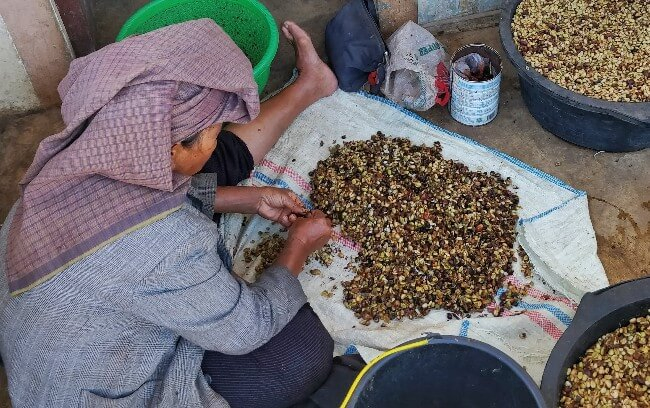
Remember the coffee fields
If you love nature, adventures, and coffee, there’s no better way to enjoy a holiday than going to a coffee region and seeing the natural habitat of this magnificent plant for the first time.
Most of all, what you realize by visiting a coffee farm, is how much work goes into every step of making a delicious product for the end consumer.
Before visiting the coffee mountain, I didn’t understand that every tiny bean has been picked by hand in a country far away.
To produce one pound of green coffee beans, you’ll have to pick around 7 pounds of cherries. These cherries have to be ripe, and often they are growing on hill slopes, surrounded by other bushes and trees. It’s a physically demanding job.
Sure, you can read about all this. But going there by yourself will alter your perspective.
Nowadays, I almost feel physical pain when I see people wasting just a few scoops of coffee.
And that’s almost the best thing about going on a coffee pilgramage; it teaches you gratitude for the coffee farmers doing all the hard work, and it shows you that coffee is a fruit rather than a standardized product.
Top Featured Image: Jack Hebert – Flickr CC | Source
FAQ
Coffee needs an environment that mimics mountain areas in tropical countries. As such, it can be grown indoor even in cold countries. To grow outside, it’s a lot more challenging to find the right conditions. Especially, if you plan on harvesting the cherries.
For growing Arabica coffee beans, mountain areas on both sides of the Equator are the most suitable geographical locations. A nutrious soil and shade trees are also very beneficial to the coffee seed. The higher the altitude, the better.
Ripe cherries are usually hand picked by manual laborers. This means that each tree must be visited several times. In commercial coffee farms, machines are often used for harvesting, which results in many unripe cherries being picked.
